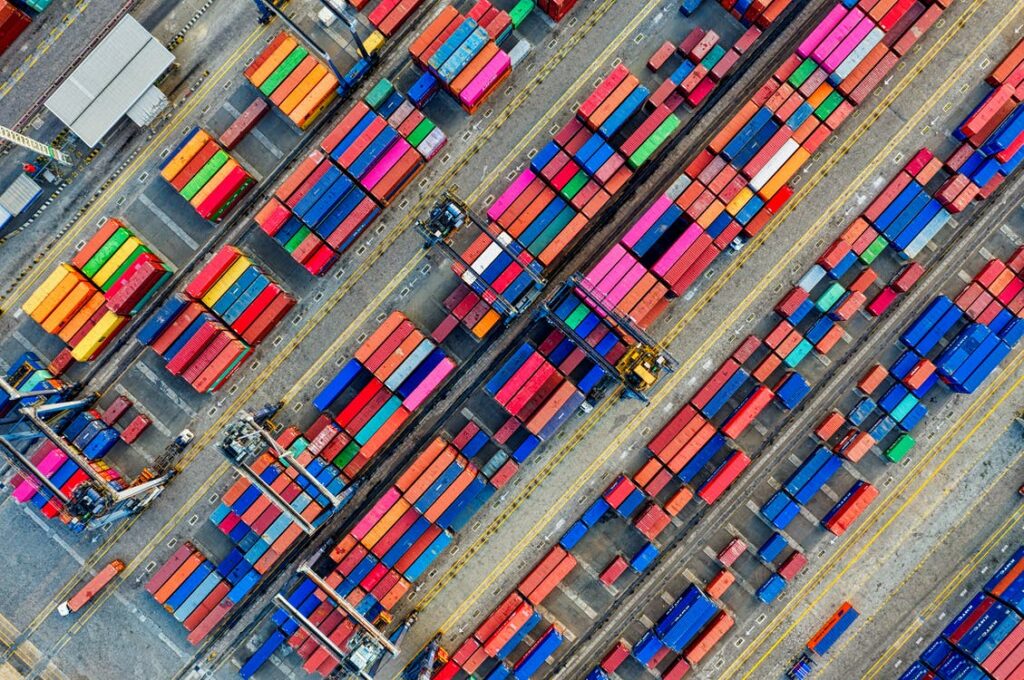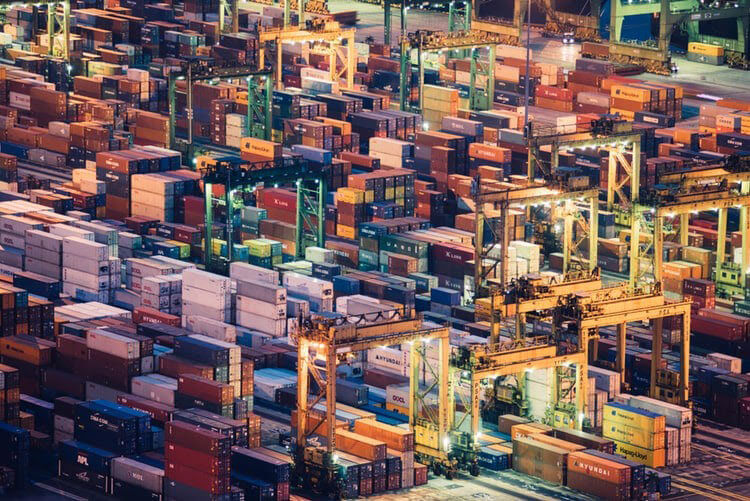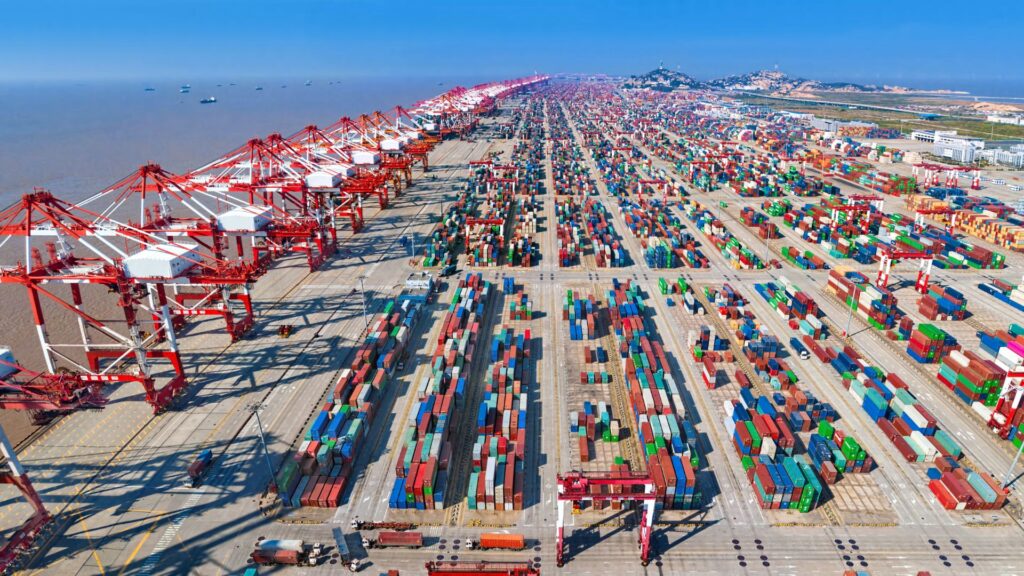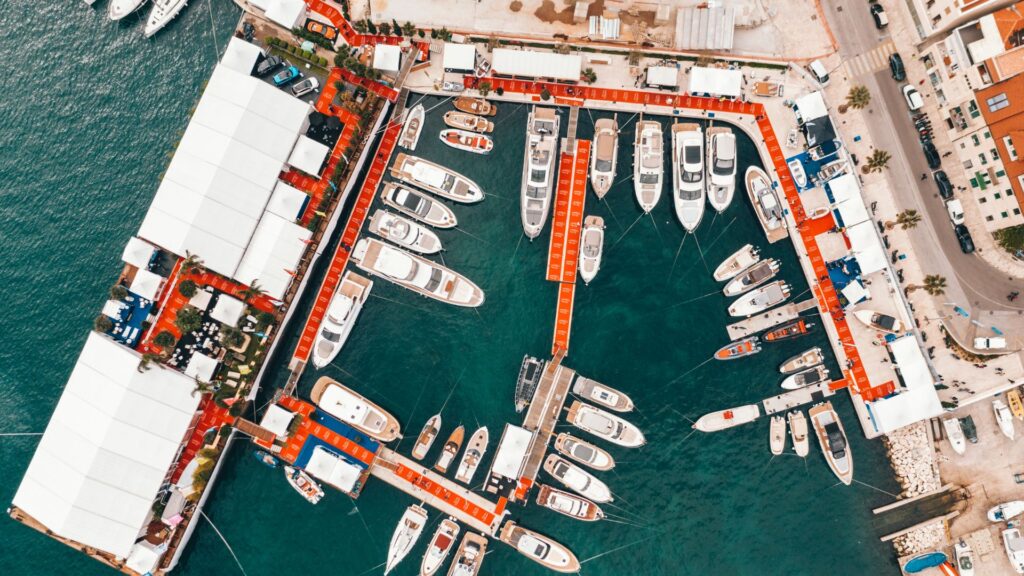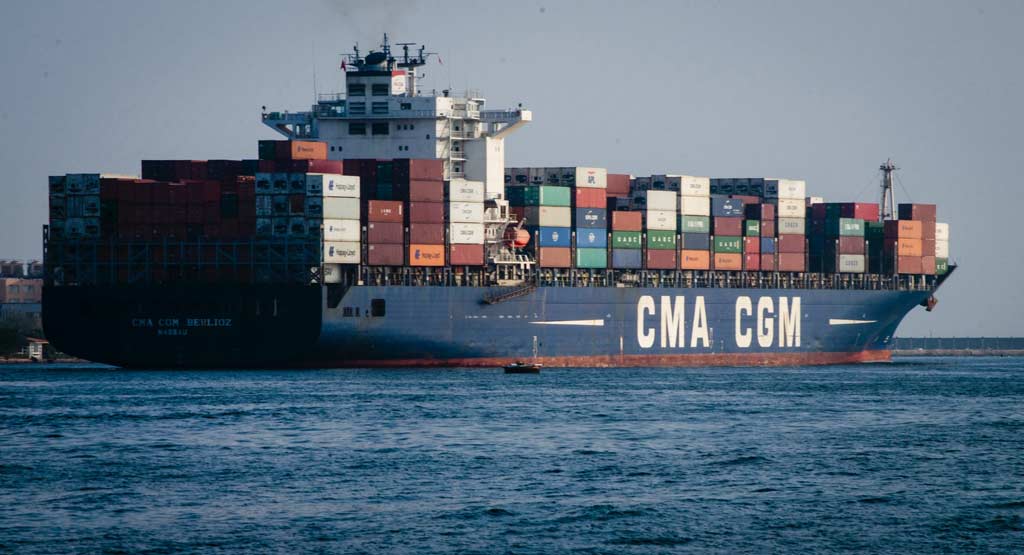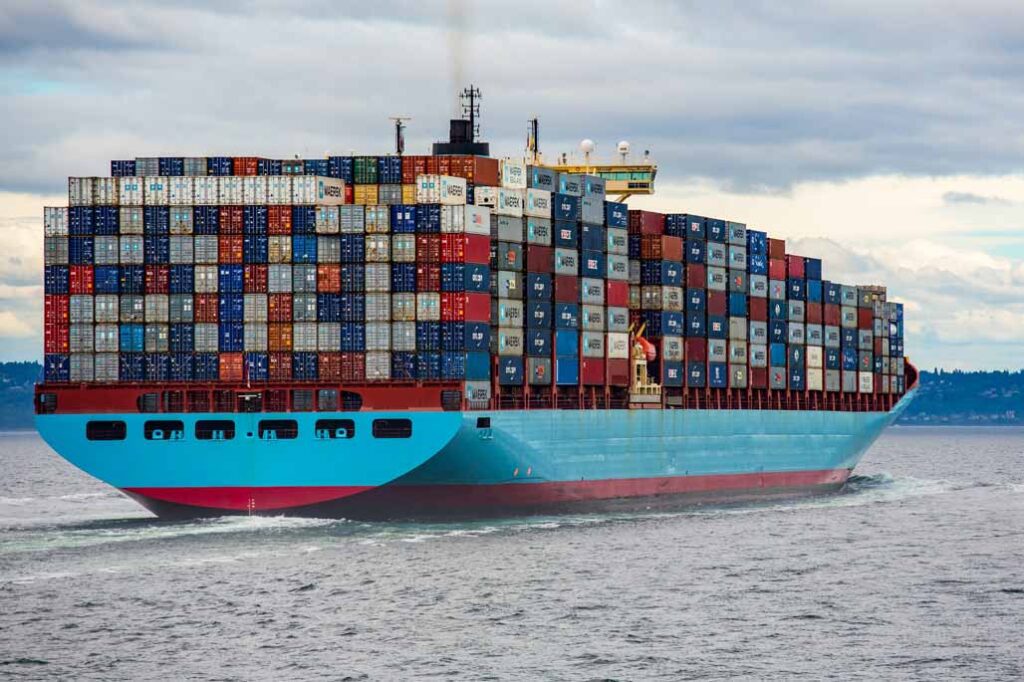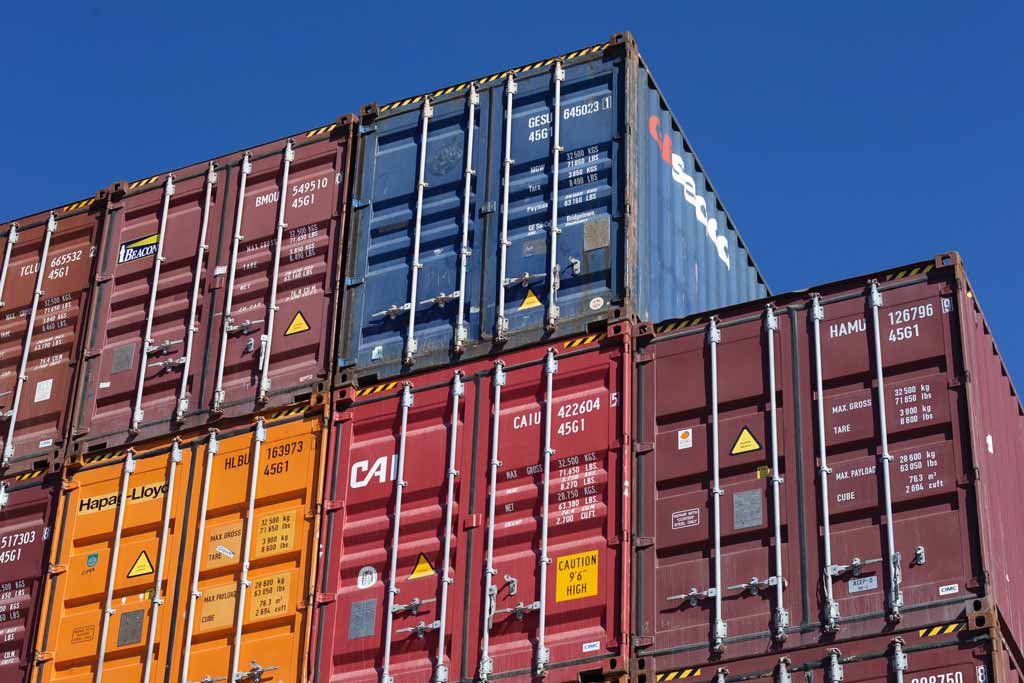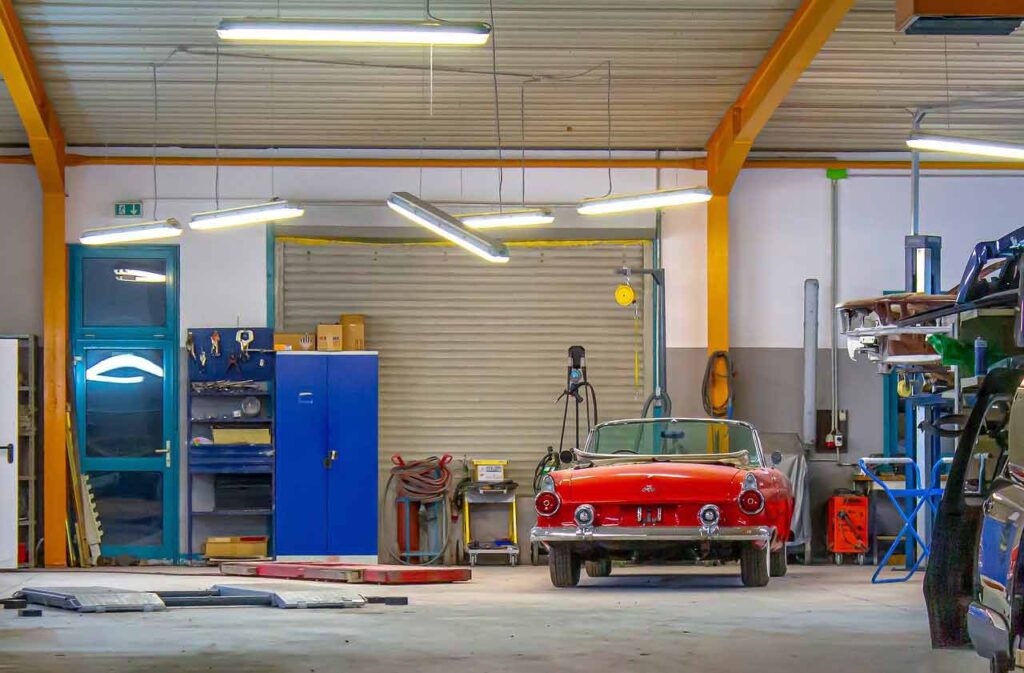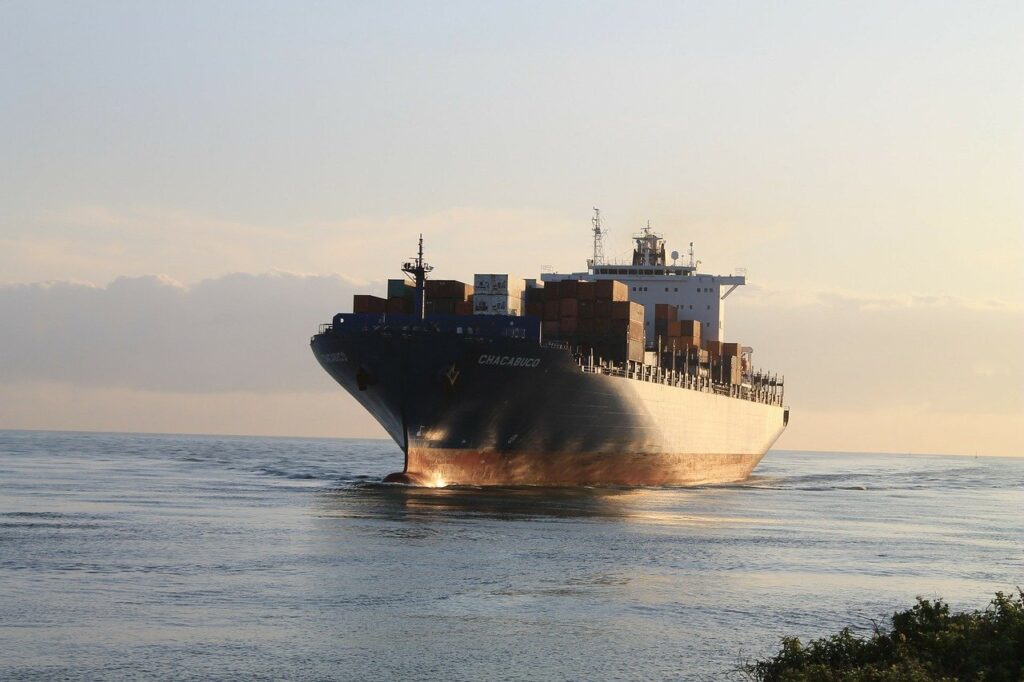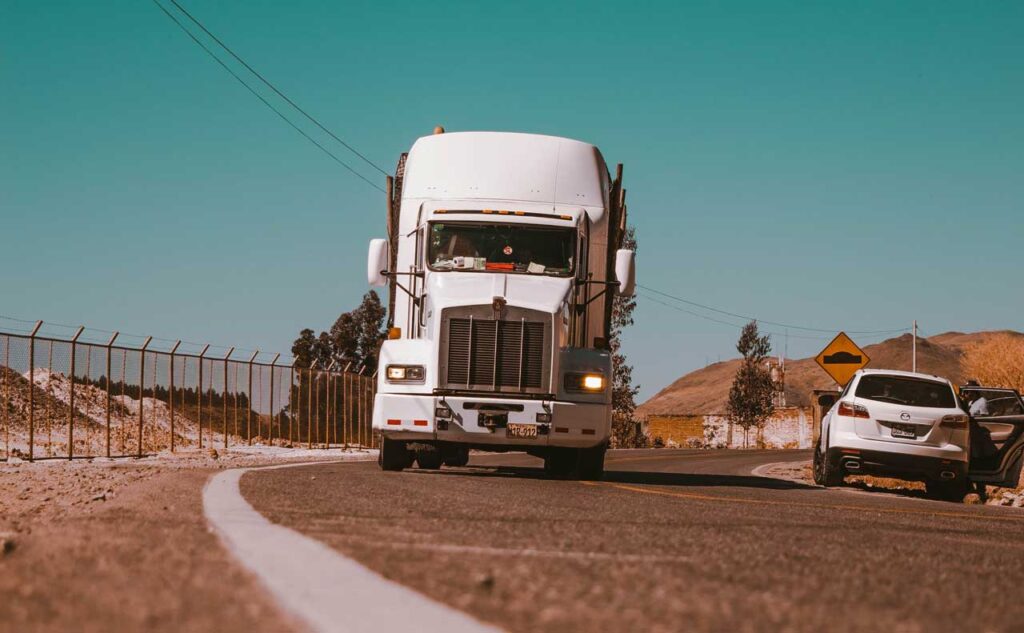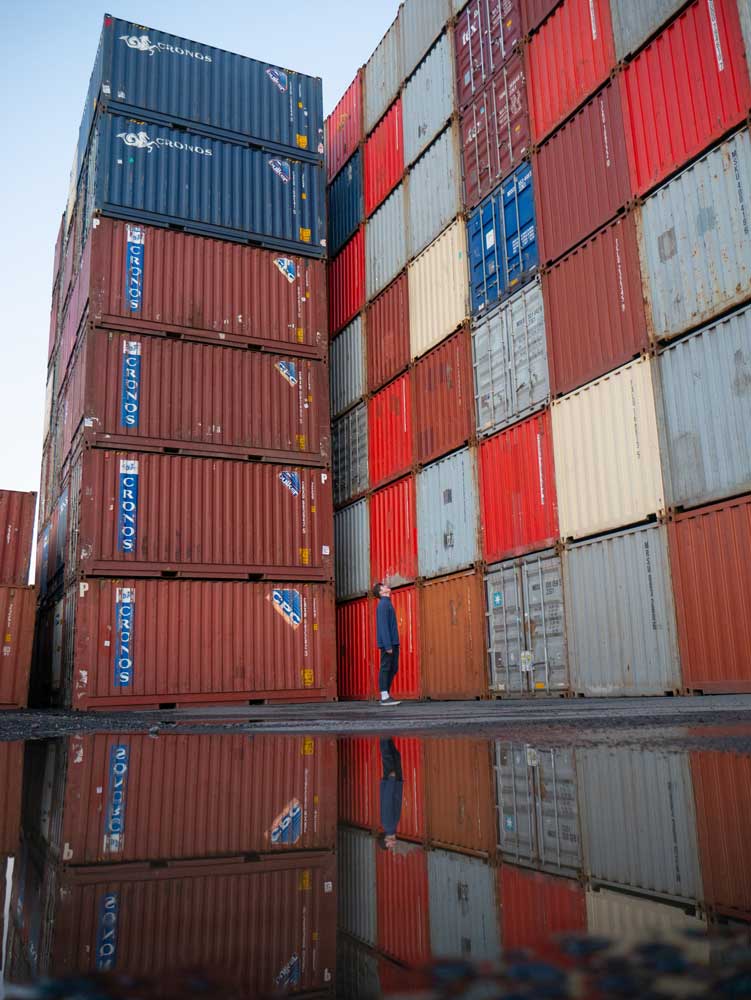Imports rose in January 2023, but quickly went down in February 2023.
What does the next few months have in store for supply chain and the logistics industry?
Unfortunately, it’s hard to say, but what we do know is that imports increased by 7.2% at the beginning of the year. However, the metrics are still down compared to 2019 and early 2020 data. The good news is that in January 2023 US logged the highest monthly gain since May 2022, the bad news is – the statistics are almost the same as the metrics from before the COVID-19 pandemic, 4 years ago.
According to Port Trucker there are even worse news – February will be the slowest month for many Shipping Companies, this prediction is based on the metrics not looking great since the beginning of the month. To quote Jonathan Gold, the NRF’s vice president for supply chain and customs policy – “February is traditionally a slow month, but these are the lowest numbers we’ve seen in almost three years’’.
The levels of uncertainty about the future of imports in 2023 are almost the same as at the beginning of the pandemic in 2022. In many ways January and February are similar to 2020, when the economy shut down as a result of the pandemic and many companies were unsure of what’s going to happen next. Now the economy is slowly coming back to normal, but the uncertainty surrounding the future is almost the same as it was in 2020. This is a challenging time for supply chain and the whole logistics industry, but it’s crucial to remember that the predictions are based on key, but ever-changing factor – the economy.
On a more positive note – the experts predict that the next months, especially March-June will show a huge growth in metrics when it comes to imports. Experts predict that the amount of imports in March will be above the 2019-2018 levels.
Speak to our Agents at Trans Global Auto Logistics today to find out more information and book your place as soon as possible to ensure the shipment will arrive at its destination on time.
Port congestion in Europe has significantly impacted the logistics industry over the last couple of years. The experts predict that this will impact the industry for the majority of 2023. Many vehicle shipping companies are affected by the waiting times, costs, and delays in vehicles delivery – which also affects the customers.
The increased competition for port space has been one of the biggest challenges for any logistics company this year. The waiting time for cargo ships to be loaded and unloaded has increased dramatically, which means that many shipping companies are struggling to secure a cargo space to transport their vehicles. The result is also increased shipping times for customers and in some cases increased costs.
The 2020 COVID-19 pandemic had a massive impact on vehicle shipping companies and the logistics industry overall. Reduced capacity at ports, social distancing, increased health and safety protocols makes the transport of goods much more complicated than it was before the pandemic. Even in 2023 the COVID-19 pandemic is having a big impact on the automotive industry; customers are experiencing delays and disruptions in delivery of their vehicles.
However, in 2023 the pandemic isn’t the only reason for Europe’s port congestions. The war in Ukraine, potential of increased regulations and tariffs on trade in the European Union are also concerning for the shipping industry. All the new measures put in place will likely further impact the time and cost of shipping vehicles through European ports.
Europe’s port congestions affect the vehicle shipping industry worldwide. Since the port congestion started companies are exploring alternative shipping routes and the whole industry is working to improve the shipping efficiency and increase the capacity at ports. The positive news is that vehicle shipping is a complex process involving many people and organisations, and many people are working to make the ports function better and make the vehicle shipping a smoother process.
The industry is greatly affected by the current and expected congestions, the rising costs and longer waiting times. At Trans Global Logistics we believe in full transparency and keeping our customers informed of anything that could impact the shipping times of their vehicles. We believe that with proper collaboration and further measures in place the situation will be improved and the vehicles can be shipped to its new destination in a timely manner and reasonable cost.
In the midst of widespread global supply chain backups including port gridlocks and international shipping delays, the United Nations has committed to reducing the problematic ecological effects of so much shipping. Countries have pledged to work together to create green corridors as zero-emission shipping routes in a recent plan that looks to the future of the world. Learn more about the context and importance of these pledges below.
What is the Clydebank Declaration?
At the United Nations global climate summit in November 2021, 22 countries, including the United States, came together to agree to a specific course of action to focus on making shipping more friendly to the environment. Their commitment is referred to as the Clydebank Declaration, pledging to work together to invest, promote, and create clean energy infrastructure at ports. The pledge invites the creation of green corridors between ports for more eco-friendly alternatives to the fossil fuel usage of major trade routes that are currently extant. The Clydebank Declaration aims towards “reducing the maritime sector’s emissions to zero by 2050,” according to the LA Times.
The important context of the Clydebank Declaration is that it “comes as the ports of L.A. and Long Beach, the busiest in the U.S., face increased scrutiny over cargo ship logjams and worsening air pollution,” as the LA Times explains. One attorney remarked that “what was already a bad situation” in terms of delays and shortages with supply chain slowdowns and lockdowns is “made worse from an air pollution perspective.” While it is important to understand how higher costs and more delays can affect holiday shopping, air quality around ports should also be a concern.
Where did this declaration come from?
The Clydebank Declaration did not just come out of the blue. The lingering effects of the pandemic have led the United Nations to be more aggressive with their plans for climate-focused changes, goals that go towards the Paris climate agreement made in 2015 which focuses on limiting global warming, bringing together all nations in a common cause. Just as every country has been affected by the pandemic, every country is affected by climate change. It takes a united globe to enact lasting change towards helping the environment. Essentially, the Clydebank Declaration seeks to curb shoreline air pollution by transitioning ships to cleaner sources of power. This is a common goal for the world to prioritize the environment for all of our sakes.
And, for your information, this is referenced in the name of the United Nations’ declaration. Clydebank is a Scottish town, literally situated on the banks of the Clyde River. Serving as the historic center of the Scottish shipbuilding industry, Clydebank is still a place involved in maritime activities. Naming the declaration after Clydebank demonstrates the United Nations’ understanding of the past and present of shipping as we move towards a better future. Now that we understand the recent declaration asking us to prioritize greener shipping solutions, let’s get into how this prioritization can be done through the concrete creation of special trade routes that are focused on helping the environment.
What are green corridors?
As part of the commitment in the Clydebank Declaration to create zero-emission shipping routes, the Getting to Zero Coalition report recommended the creation and use of green corridors. But what are these corridors and how will they help with the environment? As defined by the Maritime Executive, a green corridor refers to “a shipping route between two major port hubs on which the technological, economic and regulatory feasibility of zero-emissions ships is accelerated by public and private action.” So, these corridors are routes that will become “green” or environmentally friendly. From fuel producers and vessel operators to regulatory authorities, change is possible with support from all relevant parties.
The Getting to Zero Coalition report noted in the preface that green corridors can constitute “targeted regulatory action and route-specific collaboration in the value chain,” “with a focus on scalability and replicability,” which will be necessary to promote zero-emission shipping routes in 2021. Overall, as Maritime Executive declares, “the creation of green corridors offers the best opportunity to accelerate progress in tackling challenges of decarbonizing the shipping industry.”
Why is striving towards zero-emission shipping important?
Since most cargo ships are powered by “dirtier” diesel fuel than what’s used in cars, “the shipping industry is a major emitter of planet-warming greenhouse gases” on a global scale, as the LA Times warns. The Maritime Executive explains that the “shipping industry…is responsible for approximately 80 percent of global trade” and “accounts for about 3 percent of total global CO2 emissions.” That might not seem like a lot, but the LA Times gives context: “cargo ships collectively spew an average of 1 billion metric tons of carbon dioxide into the atmosphere each year, about as much as all U.S. coal-fired power plants combined.”
And that much carbon dioxide emission is not good for the environment or us. It’s not just that it’s harder for people with asthma to breathe or harder for us to see the stars at night; these emissions are permanently changing the earth, which can affect the planet’s habitability. So this is critical for individual and global health on a planetary scale. “Saving the planet” isn’t just a nebulous idea; it’s a concrete focus the United Nations is trying to promote.
Shipping for the People
As an expert in shipping for over 30 years, Trans Global Auto Logistics provides shipping for the people. The current attention to shipping and advocating for more ecologically efficient shipping is exciting, thinking of a world of zero-emission shipping using green corridors that were created as part of international efforts to work together for each other. We are proud to be a part of the important efforts going forward internationally as we work together to make the world a better place. If you are interested in our expertise or specifics about our processes, please contact us for more information. We’d love to talk to you about your individual questions or concerns.
The Pacific Ocean is the largest and deepest body of water on earth, covering more than 30 percent of the planet’s surface. Tropical storms and rogue waves make the ocean among the roughest waters in the world to navigate. Oaring for weeks across 50-foot waves alongside massive blue whales makes rowing across the Pacific Ocean one of the toughest journeys on earth, though certainly, the whale sightings help!
According to the Ocean Rowing Society, less than 440 rows have been completed successfully across the world’s oceans. The extreme physical, mental, and emotional challenge, though, will not stop the Endurance Limits team from rowing across the Pacific Ocean in an attempt to break a world record. With support from Trans Global’s Pacific Ocean transport services, Endurance Limits will try to make rowing history to raise funds for a good cause.
Who are Endurance Limits?
Endurance Limits are a team of four friends who are no strangers to extreme challenges. These men are not endurance athletes or marine commandos, but normal guys with regular day jobs who enjoy pushing their own physical and mental limits. While establishing a new world record is the most challenging adventure they have ever signed up for, the team members have been on expeditions in the past that have stretched the limits of human endurance.
Endurance Limits Team Members
Darren Clawson, a police officer and the founder of the Endurance Limits team, has raced in jungle marathons and run across an entire country. Clawson’s police colleague, Aaron Worbey, has competed in rowing races across the Pacific Ocean. Darren Baker is a financial planner who has participated in many ultra-endurance swimming competitions. Simon Evans, an executive at an IT consulting firm, has taken part in plenty of rowing and cycling sporting events.
While Endurance Limits’ crew members may seem like your typical thrill-seekers, these guys are not competing in a world-record-breaking rowing race to get an adrenaline high and make a name for themselves. With help from TGAL’s Pacific Ocean transport services, Endurance Limits will strive to set a new world record to gain publicity and raise funds for their charitable missions.
Endurance Limits’ Mission
Endurance Limits was born from Hadley Clawson’s struggle with a rare form of epilepsy. The rare disorder caused Hadley to experience debilitating seizures throughout his life, which eventually left him mentally impaired and physically disabled. Hadley now lives in St. Elizabeth’s Centre for people with epilepsy and other profound disabilities, receiving 24/7 specialist care for his complex medical needs.
Hadley is Darren Clawson’s son, the founder of Endurance Limits. Darren formed the Endurance Limits team with three of his most daring and determined friends to help vulnerable people like his son live life to the fullest. The team is rowing across the Pacific Ocean to raise funds for charities and organizations that help people live healthier and more fulfilling lives. Endurance Limits’ charitable missions include:
Building a New Health Center
St Elizabeth’s Centre, where Hadley currently lives, has launched a fundraising campaign to build a new specialist healthcare facility so they can deliver better care to their physically and mentally impaired residents. Endurance Limits came up with the idea of rowing across the Pacific and setting a new world record in order to raise $150,000 for upgrading St. Elizabeth’s facilities.
Building an onsite health center will not only benefit St. Elizabeth’s residents, but it can also improve the lives of thousands of people around the world. St. Elizabeth’s specialist health center can provide valuable data and clinical trial participants to world-renowned research programs, helping scientists find new solutions for neurological disorders like epilepsy.
With logistics support from TGAL’s Pacific Ocean transport services, a world-record-breaking row across the Pacific will bring more attention to St. Elizabeth’s fundraising campaign, helping them acquire enough resources to build the needed facility.
Increasing Awareness of Alternative Treatments
Endurance Limits is promoting and raising funds for Matthew’s Friends to increase public awareness of alternative treatment options for epilepsy.
Matthew’s Friends is a non-profit organization that educates and provides resources to families that want to adopt ketogenic therapies for relieving epileptic seizures.
Numerous studies have found the ketogenic diet to be very effective in patients that do not respond to anti-epileptic drugs. Rowing across the Pacific with a Matthew’s Friend logo on Endurance Limits’ boat will bring the organization into the spotlight and increase people’s knowledge on alternative treatment options for chronic seizures.
Supporting Cleaner Oceans
The world’s oceans are choking on plastic pollution. In the Pacific Ocean alone, an area three times the size of France has become one of the largest dumps for plastic garbage in the world. Plastics have toxic chemicals that harm both marine and human health. Toxins from plastic waste in the oceans enter the human food chain through seafood and tap water, causing neurological disorders like epilepsy among other health conditions.
With support from TGAL’s Pacific Ocean transport services, Endurance Limits will use this world-record-breaking event to raise money for The Marine Conservation Society’s (MCS) Clean Seas program. MCS is working with governments, businesses, and communities around the world to reduce plastic pollution and promote cleaner oceans. Rowing across the Pacific and breaking the current world record will help MCS’s fundraising campaign gain more public attention and resources, supporting cleaner oceans and healthier lives.
The Current World Record in Pacific Ocean Rowing
To get maximum publicity for these charities and raise funds for their philanthropic goals, Endurance Limits must try to break the current world record in Pacific Ocean rowing. The current world record was set during the Great Pacific Race in 2016 by the Uniting Nations team.
Uniting Nations was able to row from Monterey, California, to Honolulu, Hawaii, in 39 days, 9 hours, and 56 minutes, setting a new Guinness World Record as the fastest westbound crossing to Hawaii. Endurance Limits must break Uniting Nations’ record to make rowing history and accomplish their charitable goals.
TGAL’s Role in Helping Endurance Limits Break the World Record
Trans Global Auto Logistics is honored to help Endurance Limits row across the Pacific Ocean in record time so they can accomplish their charitable goals. TGAL is not only sponsoring the event, but will also handle all of Endurance Limits’ Pacific Ocean transport requirements to help the team make rowing history. With more than 30 years of experience in international boat shipping and ocean transportation, TGAL has the expertise needed to facilitate the logistics of this high-profile sporting event.
Endurance Limits is building a new rowing boat at a manufacturing facility in Devon, UK, to participate in this event. The boat should be shipped through the Atlantic and Pacific Oceans to reach its destination port in Monterey, California. From Monterey, California, the team must row 2,700 miles across the Pacific Ocean to Honolulu, Hawaii, in less than 39 days to break the current world record. TGAL will manage all of Endurance Limits’ shipping needs across multiple oceans so the team has more time to prepare for setting a new world record.
The Process of Transporting Endurance Limits’ Boat
A fully bonded and licensed freight forwarder, TGAL uses its relationship with multiple logistics and shipping partners around the world to transport Endurance Limits’ boat to its final destination. Our Pacific Ocean transport services start by hauling the boat from its manufacturing facility in Devon, UK, to delivering it at the destination beach in Monterey, California. Below, we explain the seven processes that TGAL goes through to ship Endurance Limits’ boat for rowing across the pacific:
- Export haulage – TGAL arranges for the boat to be transported on land from the manufacturer’s premises to the warehouse of a shipping partner in the UK.
- Export customs clearance – Our shipping partner will submit the required documents to UK authorities to clear the boat for export.
- Origin handling – The boat is inspected, placed inside a container and then moved to a seaport where it is loaded onto a ship.
- Ocean freight – The boat is transported by a shipping line or charterer contracted by TGAL.
- Import customs clearance – TGAL submits documents and pays customs duties to US authorities to obtain clearance for importing the boat.
- Destination handling – The container with the boat is unloaded from the ship and transported to one of TGAL’s warehouses.
- Cargo delivery – TGAL delivers the boat to Endurance Limits in Monterey, California, for rowing across the pacific.
Partner With TGAL to Transport Your Boat Around the World
Do you need Atlantic or Pacific Ocean transport services to ship your vessel to another country? From fishing boats to superyachts, we can help you transport vessels of all shapes and sizes to any destination of your choice, while preventing damage and maintaining their pristine condition. Call us at 972-602-1670 to inquire about our international boat shipping services or request a quote for transporting your vessel to another country.
Global shipping is in chaos. After somewhat recovering from a COVID-19 recession, the industry is now battling a confluence of disruptive factors that have led to an international transportation crisis. From manufacturing plant shutdowns in North America to goods piling up on Chinese factory floors, an extremely tight logistics capacity is disrupting international trade on a scale not seen in modern history.
The international shipping capacity crunch has sent global supply chains into disarray, posing a challenge to post-COVID economic recovery. Tight capacity is causing manufacturing disruptions, transportation delays, and higher shipping costs, adversely impacting the supply chains and profit margins of many businesses. Let’s review tight capacity, what it is, and how our team at Trans Global Auto Logistics (TGAL) can be your partner in navigating the issues involved.
What is Tight Logistics Capacity?
Before delving into tight capacity, let’s first try to understand what capacity means in the logistics industry. Capacity in the logistics industry is the maximum amount of cargo that can be carried by transport modes like trucks, trains, and ships. In simpler terms, capacity is the amount of shipping space available for transporting goods to their destination.
When there is more capacity supply than demand, we experience overcapacity. But when there is more demand for capacity than available supply, we experience tight capacity. Many factors, some of which stem from the pandemic, have led to the current tight logistics capaaity around the world. Below, TGAL will explain how insufficient shipping container capacity, congested ports, and labor shortages are causing the global transportation crisis we’re facing today.
Why is There Tight Capacity?
Some factors that contributed to the current disruption in transportation, like labor shortages, existed before COVID-19. But a cascade of events that followed the global pandemic have created an international logistics crisis, squeezing all parties involved in the global supply chain. Some factors that have caused the current tight logistics capacity include:
Increase in Demand
As countries locked down and imposed stay-at-home orders, online shopping became most people’s favorite pastime. Lower fuel costs, a spike in eCommerce shopping, and an increased need for more personal protective and medical equipment led to more demand for shipping container capacity to transport goods around the world. Increased demand for logistics capacity led to decreased supply of available freight space, leading to the global transportation crisis we are experiencing today.
Port Congestion
COVID safety precautions have decreased the availability of dockworkers in many of the busiest ports around the world. A smaller workforce at The Port of Los Angeles ⎼ the busiest port in the United States and the main point of entry for goods from Asia ⎼ has led to slower operations and delays in handling cargo.
Ships are stuck for days offshore in floating traffic jams and empty containers are piling up at the port. There are currently more than 285,000 empty shipping containers lying idle at the Los Angeles port. Slower loading/unloading and countless empty containers sitting idle at busy ports around the world are major contributing factors to the global logistics capacity crunch.
Chinese Trade Surplus
China was the first country to get hit and then recover from the Coronavirus. As a result, its economy bounced back quicker than other countries. This uneven economic recovery led to significantly more Chinese exports heading to the US and Europe than the other way round. China is aggressively demanding empty containers to be sent back from export destinations, resulting in tighter shipping container capacity for American and European exporters.
Labor Shortages
Many countries were struggling with truck driver shortages long before the pandemic. But the pandemic quarantined some drivers and caused many others to lose their jobs, resulting in a severe shortage of truckers in many countries around the world.
Trucks are needed to haul shipping containers from ports to the rest of the country. A lack of truck drivers is tightening logistics capacity and delaying the delivery of goods to their final destination, disrupting entire supply chains across many industries.
Impact of Tight Capacity on Businesses and Consumers
Capacity constraints in the logistics industry are creating bottlenecks in international transportation, particularly with the recent issues at the Suez Canal. From manufacturers to businesses and consumers, every entity in the supply chain is feeling the pain of a global capacity crunch. Delayed or canceled deliveries of raw materials are leading to factory shutdowns in many countries around the world. Honda halted all its American and Canadian manufacturing operations as port logjams hampered parts procurement.
Along with transportation delays, constraints in logistics capacity are leading to skyrocketing shipping costs. Businesses wait for weeks and are willing to pay premium rates to get sufficient shipping container capacity for transporting their cargo. The shipping crisis has caused a three-to-six-fold increase in international transportation costs, hurting businesses’ profit margins and consumers’ pockets. McKinsey estimates international shipping costs to remain high for the next two years, threatening the viability of small businesses that rely on importing and exporting goods.
How to Deal With Tight Logistics Capacity
The international transportation crisis has forced governments and businesses to come up with new solutions for mitigating tight capacity. Congress has recently introduced a bill ⎼ the DRIVE Safe Act ⎼ that can help relieve the country’s truck driver shortage. Carriers are implementing several measures ⎼ such as adopting more efficient unloading systems and reducing container detention periods ⎼ to help ease the shipping capacity crunch.
Despite all these measures, the logistics capacity crunch will not go away anytime soon. A fast-recovering global economy along with fewer shipping containers in inventories mean the transportation crisis is here to stay for the foreseeable future. Businesses need to form long-term partnerships with shipping providers to get priority access to limited capacity when they need it.
Getting Affordable Rates During Tight Capacity
If you run an import and export business or just need to ship your personal goods to another destination, the shipping container capacity crunch will make it difficult to transport cargo cost-effectively. Many logistics companies will charge you hefty fees for shipping your freight, which can put a big dent in your wallet or damage business finances. To combat the high costs of tight capacity, you need a logistics partner with extensive experience and expertise in the industry to get the most competitive rates for your freight.
Partner With Trans Global to Get Competitive Rates
With more than 30 years of experience operating in the freight and transportation industry, Trans Global Auto Logistics (TGAL) has the knowledge and expertise needed to overcome the challenges of tight logistics capacity. We have built solid relationships with numerous shipping lines and charterers over the past few decades, allowing us to get the most competitive rates in the market during times of shipping container capacity shortages.
Unlike other freight and logistics businesses, we own our warehouses, which helps us offer lower-cost shipping services to our customers. If you’re struggling to get affordable rates for shipping your cargo because of tight logistics capacity, we can help. Call us at 972-559-3229 to learn more about our transportation services or request a quote for shipping your cargo.
Are you dying to get your hands on a 1960s muscle car you saw online? Or perhaps you’re thinking of buying your neighbor’s vintage Ford pickup truck because it brings back fond childhood memories. Whether you plan to buy a classic car for investment or keep it as a collectible, purchasing used vehicles can be risky. A test-drive around the block or a quick scan under the hood is not enough to help you identify potential problems with the car.
Classic cars can have many cosmetic, mechanical and safety issues, which can’t be detected by analyzing online pictures or performing a simple visual inspection. Before you plunk down thousands of dollars for buying and shipping your classic car, you should get an accurate picture of the vehicle’s condition. A professional pre-purchase inspection will help you identify any issues with the vehicle so you can decide if the classic car is worth your money.
What is a Pre-Purchase Car Inspection?
A pre-purchase car inspection is a professional assessment of a used vehicle to identify any mechanical, structural or aesthetic damage. Classic car inspections are performed by certified mechanics or automotive technicians that have expertise in the make and model of the vehicle being purchased. Pre-inspections allow buyers to find out if the car is worth its asking price, helping them save thousands of dollars by preventing the purchase of damaged goods.
Classic car inspection services give buyers peace of mind as it helps them ensure that the vehicle is not a financial liability. Most experts recommend taking a used car for a comprehensive inspection before completing the purchase. If you intend to purchase a classic car online or from another state, Trans Global Auto Logistics (TGAL) can help you with the pre-inspection, payment, and shipping process. TGAL offers classic car inspection and escrow services for online and out-of-state purchases to protect buyers from fraudulent deals and have the car shipped to their doorstep.
Where Can You Get a Pre-Purchase Classic Car Inspection?
Although most mechanics and auto technicians can perform a pre-purchase inspection, it is best to take the desired vehicle to classic car specialists. Try to find a professional that has experience and expertise in providing inspection services for the type of classic car you intend to purchase. If you want to buy a 1964 Pontiac GTO, make sure the inspector has sufficient knowledge of muscle cars. Buying a 1956 Ford F100, however, does not require muscle car expertise.
To find a pre-inspection professional with speciality in the type of classic car you want to buy, turn to Google for help. A quick Google search can help you find plenty of classic car inspection service providers in your area. If you’re purchasing a vintage vehicle from out-of-state or an online marketplace, TGAL can help you with the classic car inspection process. No matter where the car is located, we’ll work with a third-party inspection service provider to produce an official report of the vehicle so you can get in-depth information about its condition.
What to Expect During Pre-Purchase Car Inspections
There are no universal standards in the industry that specify how pre-inspections should be performed. The depth and detail of pre-purchase car inspections will depend on how much you’re willing to pay for the service. A basic inspection involves a visual assessment of the body and underbody of the classic car for the presence of blemishes, rust or leaks. A thorough classic car inspection will usually take two to three hours and involve checking the following:
Body Panels
A classic car technician or certified mechanic will start the inspection process by checking the vehicle’s exterior. Classic car inspection service providers will walk around the vehicle to look for any signs of damage, flood or accident repair. Common things to look out for include:
- The paint’s finish and condition
- Presence of scratches, dents and rust
- Gaps between panels which indicate frame damage
- Quality of frames and subframes in the undercarriage
- Condition of guards, plates, and panels in the underbody
Interior Parts and Components
After examining the exterior of the vehicle, the pre-inspection procedure moves on to check the interior of the car. Everything from the car’s carpets to seats and dashboard is analyzed to determine their condition. Classic car inspection also checks to see if there are any interior parts or components ⎼ like stereos and gauges ⎼ that are missing from inside the vehicle.
An interior check of classic cars generally evaluates the condition of:
- Seats: Are they soft and comfortable or hard and dry?
- The headliner: Is it firm and in-place or sagging and falling?
- Carpets: Are they in good quality or worn out?
- The dashboard: Does it close properly or has cosmetic issues like cracks and scratches?
- Glass: Does it have any stars, chips or cracks?
- The trunk: Are there any signs of water damage?
Mechanicals
After examining the exterior and interior condition of the classic car, the pre-inspection process gets deeper and more technical. At this stage, the technician or mechanic will open the car’s hood to analyze wiring, fluid levels, the battery, engine, and other electrical and mechanical components. A mechanical analysis conducted during a classic car inspection service usually involves checking:
- The quality of hoses and belts
- Fluid levels to see if they’re normal
- Potential problems with the suspension
- How well the electrical components function
- The air cleaner to see if it is properly installed
- The condition of brakes, drivetrain, and engine
- Leaks in valve covers, the lower rear of the engine, and around the carburetor
Tires
Classic car inspection checks the vehicle’s tires to determine if they’re usable or need replacement. Technicians will look for signs of wear such as bubbling or cracking on the tires’ sidewalls. Pre-inspection will also analyze the tire’s tread. Classic car tires should have at least one-third of an inch of tread on them to indicate they’re in good condition. If the classic car inspection service reveals that the tires have uneven tread, it could mean that the vehicle has suspension issues.
Mold Growth
If a classic car was not properly looked after, it will have molds and mildew on its interior components. Fungal infestation takes place inside classic cars that were exposed to moist environments. Pre-inspection will check the car’s interior for signs of fungal contamination to determine whether the vehicle has experienced water damage.
Car’s Performance
After checking the car’s exterior, interior, and mechanicals, classic car inspection will analyze the vehicle’s performance. Technicians will start and test-drive the car to look for any signs of engine, transmission, brake and other problems that they could not identify during previous assessments. Classic car inspection service providers test-drive the vehicle to find out if:
- It starts easily or requires multiple attempts
- The engine runs smoothly or is rough and rigid
- Gears shift without making horrible grinding sounds
- Steering is loose, shakes, or produces any noises under the car
Get a Pre-Inspection Before Buying a Classic Car
Buying any used vehicle, especially classic cars, can pose significant financial and safety risks if you don’t inspect it thoroughly for faults and defects prior to purchase. A professional classic car inspection can cost a few hundred dollars but will save you thousands in the long run on potential breakdowns and expensive repairs.
If you’re planning to buy a classic car online or from another state, Trans Global can help you every step of the way. TGAL offers third-party inspection, escrow services and direct-to-door shipping to help you buy your dream classic car with the least worry. Call us at 972-559-3295 to learn more about our classic car inspection service, or request a quote for inspecting and shipping a vintage vehicle.
The world continues to feel the impact of Brexit. Shipping to Europe and the UK has changed, both in the short term and the long term.
But what do the Brexit shipping impacts mean for you, the consumer? Do the Brexit and shipping industry complications have much visibility for shipping customers? How is shipping different going forward in a post-Brexit world?
Today in the Trans Global Auto Logistics Blog, we are looking at Brexit, shipping to Europe and the UK, impacts on the shipping industry, and how all of this affects you.
The Big Picture Summary
The bottom line for shipping customers is that Brexit will have an overall negative impact on international shipping for the foreseeable future, particularly shipping to and from the UK. Some of the key trends to expect are:
- Higher shipping costs
- Longer shipping times
- Unexpected delays (mainly in the near future)
- Greater regulatory burdens
- More logistical complexity in the process
- Reduced availability and breadth of shipping services (mainly in the near future)
When it comes to Brexit and shipping industry companies, the market will gradually resolve most of these problems. But it will take years, and some of the problems are probably here to stay.
Meanwhile, there are some localized winners. If you’re a non-UK goods company who directly competes with UK companies on the international market, you may gain an edge — especially in the short term. With Brexit, shipping to Europe and elsewhere is easier right now if you’re not in the UK.
Immediate Post-Brexit Shipping Impacts on the UK

Highlights: Disruption, Disruption, Disruption
- Shipments into the UK — not just from the EU but globally — were disrupted due to Brexit-related tax collection issues, as many shipping companies were not set up to handle the new and uncertain tax obligations.
- Shipments into the UK were also disrupted due to pandemic-driven fluctuations in consumer demand, container shortages, and port congestion. Brexit made things considerably worse by creating a spike in demand at the end of 2020.
- These problems triggered a reduction in service to the UK by mainline cargo carriers, making things for the UK even worse still.
- Post-Brexit shipping to Europe and Northern Ireland from the UK (Northern Ireland continues to abide by EU single market regulations) met with new uncertainties, delays, and the aforementioned reduction of mainline carrier services to and from the UK.
Shipping Rates Soar
One of the first and biggest Brexit shipping impacts was that shipping rates exploded. Most notably, rates from Asia into the UK spiked fourfold, reaching record highs.
This was due to a massive spike in consumer demand, especially in the UK — where citizens were eager to take advantage of the European single market while they still could, and had excess funds to spend on consumer purchases due to reduced availability of hospitality services during the pandemic. This caused a flurry of Brexit shipping to Europe and the UK from Asia.
This surge in imports from Asia led to UK port congestion, exacerbated by staffing shortages due to COVID. and a glut of empty containers stranded in the US, UK and Europe due not only to the Brexit situation but the pandemic as well. With so many containers in the West, there were not enough containers available in Asia to meet the surge in UK demand, leading to the spike in rates.
The Good News
The good news is that the worst Brexit shipping impacts — the shipping disruptions — are going to subside, or have already been subsiding. Brexit and shipping industry companies aren’t “enemies” of each other: The demand for shipping services will be strong over the long term, which means that the shipping disruptions will ease up as the initial shock of the UK’s departure from the single market fades. So the UK’s post-Brexit shipping to Europe will eventually stabilize.
In the meantime, the UK is eager to make new trade agreements with other key trading partners like the U.S., which, once in effect, will likely have a positive impact for companies shipping to or from the UK.
A Less Favorable Customs Landscape
As mentioned, the shipping market will gradually optimize for the new, post-Brexit economic landscape. However, one thing that can’t be optimized away is the new regulatory barrier when it comes to Brexit shipping to Europe (and Northern Ireland) from the UK, and to the UK from Europe.
We expect the rise of border control and customs barriers between the UK and the EU to be one of the main long-term Brexit shipping impacts. Some of these barriers will be monetary in nature, in the form of various direct fees, and associated cost-of-compliance fees for shipping companies. Other barriers may see quotas or bans on what can be shipped between the UK and the EU.
And then of course there are the barriers of time: Brexit shipping to Europe – UK routes will definitely become and remain slower due to increased inspection times. This has already come to pass in the form of long commercial queues at border stations. Over time these bottlenecks will be solved, but the longer inspection times are probably here to stay, and will become one of the other main Brexit shipping impacts in the long term.
On a positive note, we expect, for the most part, that both the UK and the EU will try to minimize these barriers, since it is greatly in their mutual economic interest to do so. And we have seen the UK largely choose to continue to abide by, for example, existing EU environmental and safety regulations pertaining to international shipments.
Just-in-Time Inventory Management
The slower reality of post-Brexit shipping to Europe, and vice versa, is having a global impact on companies that use a “just-in-time” inventory management system. Under this system, supply chain disruptions can lead to sudden and serious shortages. Until the uncertainties are resolved and equilibrium is achieved in UK – EU shipping, just-in-time may become less desirable for some companies.
Brexit and Shipping Industry Companies
Shipping companies themselves have experienced considerable post-Brexit shipping impacts and uncertainty.
- UK shipping companies are experiencing loss of cabotage at European ports — i.e., the ability to run shipments between two non-UK terminals — making it much more expensive for them to do those kinds of routes.
- Shipping companies around the world are having to bolster their regulatory compliance to meet the merging requirements for post-Brexit shipping to Europe and the UK.
- As mentioned, there is a continued risk of the UK losing its privileged access to direct service from the mainline shipping companies. To the extent this happens, Britain will become more reliant on auxiliary / feeder carriers, which is more expensive and adds a step in the shipping process.
The shipping industry as a whole will not be particularly hurt by Brexit, and shipping industry companies are already settling into a new equilibrium. The good news for you as a shipping customer is that, as the initial post-Brexit shock fades, you can expect the reliability, availability, and breadth of shipping services to all improve, and the spike in shipping rates to come down (albeit probably not to what it was before Brexit).
Shipping to Europe and the UK is definitely still a viable option! Shipping companies have dealt with international borders long before Brexit, and shipping industry best practices are already highly advanced and ready to be applied to the UK – EU situation.
Get the Reliable International Shipping Services You Need at Trans Global Auto Logistics
The biggest takeaway from Brexit is the uncertainty that it brings. It will take decades for everything to play out. But in the meantime, when you need to ship to or from overseas, including the UK or EU, you have good options available.
At Trans Global Auto Logistics, we have responded to the flurry of post-Brexit shipping impacts by closely following developments, building out new capabilities and compliance protocols wherever necessary, and ensuring the absolute minimum of disruption to our shipping services.
We won’t be stopped by Brexit! Shipping to Euriope and the UK with Trans Global means taking the stress and hassle off your hands by letting us get it done right. We have over 30 years of experience, and are proud to offer a wide variety of shipping services and modes of transport.
Speak with Our Knowledgeable, Friendly People
We hope this article has helped you better understand the major Brexit shipping impacts in terms of customers like you who ship internationally. At Trans Global, we are ready to deal with Brexit and shipping industry complications. Trust us with your post-Brexit shipping to Europe and the UK!
- Contact us to discuss your shipment, ask questions, or get more information.
Explore Our Shipping Services
Here are some of our most popular international shipping services:
- International Cargo Shipping
- International Vehicle Imports
- Air Freight Shipping
- Household Goods Shipping Overseas
- Military POV Shipping
Also be sure to check out our resource guide, Container Shipping to the UK.
Ready to get started?
Request a free shipping quote today!
Shipping a vehicle is a great way to move it from its point of origin to a destination securely and with less wear and tear. While transporting vehicles is popular for cars that are condition-sensitive, such as classic or collectors’ vehicles, it can be a necessity for your everyday needs as well. This is especially true if there are too many vehicles to drive (like when moving across the country using a rental truck), or when you need to transport your car by air or sea.
Shipping a vehicle, however, is not a one-size-fits-all solution. There is a range of options available to tailor your car’s long-distance transport to your specific needs.
Considerations When Transporting Your Vehicle
There are several factors to weigh when you choose to ship your car. These will determine not just the method of conveyance, but the specifics of how it is conveyed.
- Condition – While all transport companies will do their best to preserve your vehicle’s state, some vehicles, like high-cost sports cars, are highly condition-sensitive and can merit a higher level of protection than a family sedan with high-mileage and parking lot “dings.”
- Price – You will find that the cost of transporting vehicles varies depending on the options you choose. You may find yourself looking for a happy middle ground between budget and bells and whistles.
- Time Frame – Shipping a car or any vessel takes time, but there are faster and slower modes of transport available. Expedited service can come at a premium.
- Paperwork – Contracting with each carrier yourself can leave you juggling multiple contracts, and international shipping involves the paperwork required for the import/export process. Even domestically, some vehicles may need special paperwork to operate in a new state, such as electric vehicles.
Modes of Long Distance Car Transport
How your vehicle reaches its destination can vary. The route you choose might be based on necessity, convenience, or budget, and can affect the timeline for your vehicle to be delivered. It’s best to understand the pros and cons of each method of transporting vehicles so you can make a more informed decision.
- Land – The simplest and often cheapest route for transporting vehicles when possible is over land. Road travel is fairly fast and there are numerous carriers and options available to give you the perfect blend of care and cost-effectiveness. Unfortunately, not all trips can be traveled by road alone, so this option isn’t always a viable choice.
- Sea – Sea transport takes longer than road transport but is often the next cheapest option, and a common choice for those who need to ship their vehicle overseas, such as executives being transferred to a foreign office or military personnel. This mode of transport sees your vehicle loaded onto a cargo ship at an export port and delivered to an import port where it’s unloaded and picked up.
- Air – Transporting vehicles by air is the fastest and, often, the most expensive option. It can be used for both domestic and international shipping, with the possibility of a shorter journey to drop-off or pick-up the vehicle depending on cargo airport availability.
- Blended – For many people, more than a single shipping method is needed. They may need ground transportation to an airport or seaport at the originating location, while at the end of the journey ground transport is again needed to pick the vehicle up and move it to the final destination.
Transport Options
When transporting vehicles, the carrier will do its best to prevent damage and keep your vehicle safe, but there are several ways to ship a vehicle that affect the level of safety and security offered.
- Open – Open transport is often cheaper but may not offer your car the protection it needs. In open transport, the vehicle is loaded onto the back of an open trailer or pulled onto the deck of a transport ship and secured. This may leave it more open to the elements, but it does allow cost-efficient transportation that doesn’t put additional wear-and tear on your daily driver.
- Closed – Closed transport is a more secure method for transporting vehicles, seeing your vehicle loaded into an enclosed trailer, a shipping container with other vehicles or property, or into the back of an airplane. It costs more, but your vehicle is more protected from the elements, potential vandals, and other shipping hazards.
- Single Vehicle Container – Single container shipping is the most secure mode of transport for condition-sensitive vehicles. Your car is loaded into its own container, with no other vehicles or cargo.
Working With a Vehicle Shipping Company
When you need to ship a vehicle, it can be tempting to begin transporting vehicles on your own. While it’s possible to do for longer trips, especially those crossing international borders, working with a reliable vehicle logistics partner can be a far better option. This takes a lot of the stress of arranging transport off your plate while engaging experts who can make your vehicle’s journey seamless.
Experienced shipping service not only has access to the equipment or carriers you’ll need to see your vehicle safely transported, but the connections to get you better prices and ease the transition of your goods across borders. They can manage customs and import requirements, and provide the guidance you need to prepare your vehicle for safe transport while advising you of the best method of transport to meet your budget and safety considerations. They’ll also be licensed and insured to protect your investment in the case of negligence, giving you the peace of mind you need for shipping a high-value resource like your vehicle.
Delivering Your Vehicle Safely
With the right planning and care, you can transport your vehicle safely to its destination. Just understand your requirements for the trip and don’t be afraid to approach experts for help with transporting vehicles. To get started, reach out to our team at Trans Global Auto Logistics to learn more and get a quote.
Ocean freight remains the most cost-effective way to move large amounts of property and goods around the world for private individuals, businesses, and governments alike. Professional ocean freight services help ease international shipping, ensure efficient transport, and are a useful resource in controlling logistics costs. As an ocean freight forwarder and non-vessel owning common carrier (NVOCC), Trans Global Logistics is positioned to help our clients move their property worldwide, whether they’re shipping a vehicle to a new duty station or arranging for the transport of their latest production run from an overseas factory. This gives us a broad insight into ocean freight and what it can mean for our customers.
What Ocean Freight Is
In the simplest terms, ocean freight is simply the movement of property via ship over the ocean, just as has been done for centuries. Modern ocean shipping, however, has the capacity to move goods that is unlike anything seen before in history.
With the advent of container shipping in the 1950s, the amount of goods that could be reliably moved by a single ship increased exponentially, meanwhile the cost to transport those goods dropped as only a single crew and ship needed to be outfitted for the journey. Ocean freight has continued to evolve, with the standard of shipping still being large container vessels, but advancements in shipbuilding created larger, faster, and more fuel-efficient vessels.
Container Shipping
Shipping containers are large, rectangular metal boxes, similar to the trailers pulled by semi-trucks or train cars. Ranging from 20 to 40-feet long, cargo is loaded into these boxes for transport. Just as moving boxes do when moving a house, these containers allow for the safe and secure stacking and moving of a wide range of cargo packed within. These also allow ocean freight services to offer their clients flexibility without cutting into their bottom line with specialized shipping cost.
- Full Container Shipping – Used for large loads from a single source, full container shipping allows clients to load a full container up to its maximum weight of around 37,500 lbs. Usually priced per-container, this can be the best way for a company to meet its bottom line when they have enough goods to fill or mostly fill out a container.
- Less-Than Container-Load – For smaller shipping orders, such as single vehicles, smaller production runs, or simply less property than a full container would warrant, LCL shipping combines property from multiple sources into a single container to share costs. Each shipper is responsible for a cost based on pieces, weight, or percentage of container occupied.
The Ocean Freight Process
Shipping goods by sea has also become easier. Far from being only the province of large manufacturers or distributors, ocean freight forwarders and full-service logistics companies have worked to remove the barriers that made it a daunting task for individuals and small businesses. The process of shipping your goods or property can be arranged with confidence that, on the other end of the journey, your property will arrive when and where it’s needed in good condition.
- Take Stock Of Your Shipment. – You’ll need to know what you’re shipping and have a general idea of its dimensions, weight, piece count, and what kind of property (vehicles, furniture, palettes) the load will include.
- Contact Your Ocean Freight Services Provider – Your shipping company will work with you on creating an estimate based on the containers needed, the speed with which you need your property transported, and the dates shipping is needed. They can also help coordinate the movement of your cargo from where it is now to the export dock, and on the other end of the journey, they can help facilitate transport from the port to its final destination.
- Paperwork And Preparation – From customs declarations to permits and licenses, you’ll want to make sure you’ve got the documentation needed to efficiently move your property across borders. In many cases, your ocean freight shipper will be able to offer resources that can help you make sure you have the right paperwork or can offer services to help you navigate the process in your export and import country.
- Loading – For full-container shipping, a container will be delivered to your shipping facility where it will be loaded, sealed, and then hauled to the port for loading onto the ship. For LCL services, your goods are usually transported to a shipping consolidator who loads a container with property from you and other clients into a single container that is then taken to the port. Containers are loaded onto a ship and secured for ocean freight transport.
- Transit – Once the container ship disembarks, it will make its way toward its destination. For full ships going to a single port of entry, this direct trip can take as little as a couple of weeks. Some vessels will stop at several ports, loading and unloading cargo, on their way to the eventual final port of call to unload. This can extend the transit time depending on where in the journey your property is to be offloaded.
- Arrival – Once your cargo arrives at its import location, the container is unloaded. Customs will review your documentation if necessary. Once approved, full container loads will then be transported to the final destination, while LCL containers will go to a receiving warehouse to be unloaded and each client’s cargo routed appropriately.
Using Ocean Freight For Your Goods
Our industry experience makes coordinating your shipping painless. As a licensed and insured NVOCC and freight forwarder, we’ve established working relationships that let us offer you efficient import, export, and transit at locations around the world. It all starts when you fill out our easy quote request form. One of our ocean freight specialists will review your information and offer you the options you need to make an informed decision about moving your property. They’ll work with you to set the proper expectations and meet your needs so your goods get where they need to be when they need to be there. Contact Trans Global Auto Logistics for your ocean freight services today.
Under the best of times, trade show transport is a major undertaking. The logistics of shipping expensive merchandise, large or small, on a deadline, setting up a display, then tearing down the exhibit, and returning the materials to where they came requires careful planning, allocation of resources, and professional expertise. Trying to maintain these operations during a global pandemic is ten times harder.
Let’s take a look at how companies that are accustomed to shipping to trade shows manage their operations, how they’ve adapted to the current reality, and what the future holds.
Trade Shows Are a Big Part of the American Way of Business
Every year, massive convention centers around the country host thirty or forty major events a year. Some of these, including boat and car shows, are open to the general public. Many more are business-to-business events at which manufacturers display their wares to wholesalers and retail buyers.
Most companies who exhibit at trade shows have an entire staff division devoted to preparing for trade shows year-round. Similarly, there are large scale logistics companies who are experienced in shipping to trade shows and are equipped to deliver any size freight to a convention site on a deadline.
Shipping to trade shows is a logistical challenge that requires specialized vehicles and equipment, including shipping containers for events of all types. Typically, exhibitors contract with a logistics company to deliver their materials to the convention site. There, tradesmen build out exhibit spaces with specialized structures for each exhibitor. However, In March of 2020, at the height of the spring exhibition season, everything changed.
Toward a New Normal
With lockdowns stretching around the world, shipping to trade shows and the accompanying operations screeched to a halt. In the months to follow, businesses that exhibit at trade shows and those that support these events, including logistics companies who were shipping to trade shows, are in a holding pattern, trying to determine a path forward. In the short term, stakeholders in the tradeshow industry find it impractical to schedule events that take months to plan in an environment of spikes and dips in COVID cases, and shifting local regulations make business as usual too risky.
Forbes magazine cites a study by the Center for Exhibition Industry Research (CEIR) that determined over 9,000 trade shows were held in 2019, contributing to over 100 billion dollars in US GDP. That same study tracks the devastating effect of the pandemic on the industry: 74% of those who responded cited “uncertainty” over local regulations as the main reason for canceling events. CEIR CEO Cathy Breden states, “The persistence of COVID-19 and the uncertainty of whether events can take place in their scheduled destinations are forcing an increasing number of U.S. B2B exhibition organizers to either postpone their events to late 2020/early 2021 or cancel them entirely.”
Online Trade Conferences & Auto Events
So, what should exhibitors and logistics companies who make their money from shipping to trade shows do in the meantime? Unfortunately, there are no shortcuts or easy answers. For those few events that are still being held, exhibitors, support staff, and companies shipping to trade shows must demonstrate their commitment to public health and safety. Mask wearing, interior set-ups designed to promote social distancing, and the sanitizing of surfaces should be mandatory. Logistics companies that are shipping to trade shows should certify that all their shipping containers for events have been sanitized.
Because no amount of precautions can guarantee safety, most organizations are holding their trade conferences online. While these events are reflective of human flexibility and ingenuity, there are important parts of the trade show experience that can’t be created. For example, buyers can’t handle expensive items, such as cars, in person. Fortunately, at Trans Global Auto Logistics, we have been able to pivot with this online shift. We’re proud to now offer you pre-inspection and escrow services for customers who buy online.
While experts warn that reopening the economy may be complicated, when the time comes to open the door to public expositions, a company or organization’s smartest bet would be to choose a large operation experienced in shipping to trade shows that can scale up quickly to meet demand. Let us be your partner in your next international auto event. Get in touch with us today to get started with a virtual pre-inspection and escrow service for your online auto show purchases.

